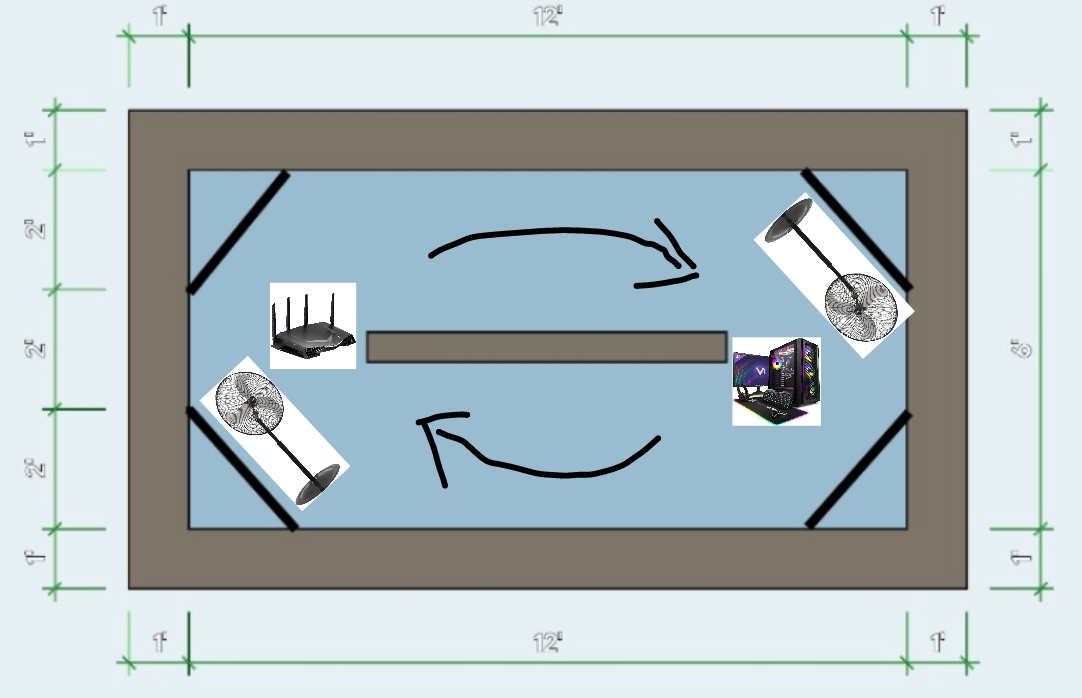Yes, but then it’s slower for your computer to talk back to your Wi-Fi, so it ends up cancelling out
Push-Pull Config

We can streamline this by making the room into 2 small tunnels from the router to the PC. This way there will be less obstacles in the room. But we need to add leafblowers on each side with a boost button.
you could also hook into the router and wireless card of the computer to make each of them turn on the corresponding leaf blower whenever they’re sending something. of course you’d probably have to implement some kind of queuing system so only one blower is active at a time, but it will all be worth it for the speed gains
What if we make the tubes really really small and wrap them in many protective layers to prevent other wind sources from messing with the signal.
At that point why even bother with the air at all, we could just send electrical signals. Or even light.
Pretty sure that’s the joke, buddy
I know pal i was continuing it on.
Who are you calling pal, friend?
RoRo stations. Roll on, roll off/out. The internet isn’t a highway, it’s a series of bullet trains in tube tunnels.
I wonder if anyone thinks OpenTTD would be more fun with a cyberspace theme? I know there’s a neon grid grf (mod)…
Anyway, if this was a suitable solution for WiFi, we wouldn’t need wired connections. That said, you can cut open a drink can to turn a WiFi router’s signal into a focused beam using the aluminum, iirc.
Full duplex airflow signal enhancement
Interestingly, this could be true and you could never find out experimentally iirc.
I watched a veritasium video about the 1 way speed of light vs 2 way that talked about it.
I watched the same video!
I was right about to disagree and type “wait this only applies to light” but then I remembered: radio is light.
Crazy to think about that!
It is nuts. It goes to show how far science goes proving things through deductions rather than direct observation. So much science is done that way.
I think that there would be some infinite energy glitches if it was actually true that light was faster 1 direction than another, so I think the assumption is a good one. But still fun facts
LOL! Yes, one has to consider this. ZOMG your’s is the best comment!
Le reddit moment tips cap to you sir
This.
Technically?
No.
There are some stupid questions.
I mean technically the weather influences your ping, since the waves travel faster at higher air pressure
I’m not sure if you’re being sarcastic but this is not true. Electromagnetic waves travel fastest in a vacuum, so the presence of air would slow it down very slightly and I would expect higher air pressure would slow it down further again only incredibly slightly because the electromagnetic waves would be traveling through a medium less efficient and more different than a vacuum.
Of course I’m making an assumption that you were using wireless signals. For all I know, you could have some weird acoustic link in which case you’d be absolutely right.
Internet via carrier pigeon. A strong headwind will reduce your effective transmission time.
They would travel slower at high pressure and high temperature due to more interactions. Low temp and low pressure are the opposite. Sound is faster with high pressure and more complicated on temperature.
Tbf, it’s not like physics stuff is always obvious, especially when dealing with relativity or quantum mechanics. It just feels obvious if you’ve already learned about the research that’s already been done.
It isn’t even remotely intuitive that light should have a max speed that can’t be added to by moving its source relative to other things. Plus, light does interact with matter, but it can only be slowed down by it.
So less a stupid question and more just one that isn’t educated about something.
Quantum physics is not logical, every other field of physics is! Shame that instead of logic we are taught fucking equations, as if we could look up logical conclusions like equations…
Even less intuitively, the fan would increase the air pressure between the router and receiver, slowing light down slightly. So it would end up (imperceptibly) slowing the signal down.
Yeah, what if I’m moving my router at the speed of light, not so intuitive now
Yeah yeah, I know. I was mostly just kidding. Everything is magic if you’re ignorant and we shouldn’t shit on people for not knowing something and props to them for asking and seeking knowledge and all that.
But it’s really sad that very basic science like radio waves which are introduced in 5th or 6th grade could be some completely misunderstood.
I remember my 6th grade science class having a lively 15 minute discussion about whether or not rockets can work in space since there’s no air…. We’re looking at videos of rockets working in space and then debating whether or not they do. 🙄
I remember my 6th grade science class having a lively 15 minute discussion about whether or not rockets can work in space since there’s no air…. We’re looking at videos of rockets working in space and then debating whether or not they do. 🙄
This feels a tad different than the person in the screenshot. Screenshot person fundamentally misunderstood how radio waves worked. Meanwhile, 6th grade you absolutely understood how rockets worked, at least to the level of understanding that they need air to work. Because you were right the whole time, those kinds of rockets can’t work in space without air. The slightly absurd solution that you wouldn’t readily know without a deeper understanding of how the rocket is built is that a rocket literally brings its own air with it!
Yeah- you make good points. I think what I was upset about was that we started with a given (they obviously work in space) and then half the class argued they didn’t for a while.
A better question would have been “how can they work since space has no air in space?” which leads to great q & a I think.
Not everyone went to the same school, and not everyone went to school, for any number of reasons. I first attended a health class in college.
On the contrary, given the premise its a smart observation from an unknownledged person.
“Wifi is waves in the air” is very very wrong but as it appears it’s what this person was thought to believe. Given that they trust this information the conclusion makes perfect sense.
The only “dumb” here is whoever explain wifi like this to them.
So what the post really amounts to is. “I applied actual reasoning to the information i was provided as fact and my conclusion seemed strange, so i will ask on no stupid questions to figure out whats really going on”
More intelligent than the majority of internet users.
it obv goes through the ether
“I don’t know, can anyone help me learn?” gets so much respect from me. Incredibly powerful mindset.
Not at all in this case though! Or rather, it depends on your perspective.
“Why doesn’t electricity leak out the outlet?” is a good question, if you know nothing about electricity.
“Why doesn’t electricity leak out the outlet?” is a little stupid, if you know a little about electricity.
“Why doesn’t electricity leak out the outlet?” is a great question if you know a bit more about electricity (because it does leak out, it’s just that 50/60Hz doesn’t couple to freespace well unless you have a colossal antenna).
As to this question, light in a moving media: https://preprints.opticaopen.org/articles/preprint/Fizeau_Experiment_Investigating_the_Speed_of_Light_in_Moving_Media/25441108?file=45147313
Oh, wow. You really triggered them this time.
This is not stupid at all. If Wi-Fi used matter instead of magnetic fields to propagate (like sound waves), a fan would affect it. Understanding magnetic fields is anything but intuitive.
Agreed, it’s just someone trying to learn.
Alternatively I would guess if fans improved the speed we’d have wifi fans throughout the house. Gaming wifi fans that sound like an airplane taking off with blinding LEDs
Imagine…
and you can speedup your upload by switching the fan direction
Fan facing up for upload and down for download, very intuitive.
don’t forget to compensate gravity
I like this question tbh
Depends on the direction the fan is facing. If it’s blowing towards you, that increases air pressure in front of it, which means more things for photons to interact with and a lower speed of light, thus slower wifi. Away from you would decrease the pressure and result in faster wifi due to the increased speed of light. Theoretically at least. I don’t think this effect is measurable.
I hope this is the final straw for OP to finally delete the app that shall not be named
Gotta get me one of those oscillating routers.
They do kind of oscillate, just very very quickly.
WiFi is waves in space, not air.
Followup: Can I get a fan that moves space instead of air? I need to make my wifi faster.
You can define your fan to be moving space and the pushing of air is the side-effect.
What poster above meant is that wifi is electromagnetic waves, so it does not care whether air is present or not. Air does not significantly hinder the propagation of electromagnetic waves. What you could do to speed up your wifi, in theory, is to fill your living room with argon. Argon has a lower refractive index than air, so the waves can travel faster. The downside is that you won’t be able to breathe.
Followup: So I need to get a fan with this symbol on it: ☢️?
There’s a few on eBay, but the sellers are all Russian and I’m not sure if they’re scams or not.
I guess I’ll look for radiation fan on Amazon.
Build your own fan out of bananas and you have a radiation fan.
So SCUBA for inside the house breathing while gaming, zoom meeting, etc. That’s totally doable.
SCBA would be enough.
It is amazing with how little to none in education is sufficient to finish school nowadays.
deleted by creator
Yes but you have to put a slit in front of it so the wifi waves turn into wifi particles.
I was an adjunct instructor at a local technical college teaching computer hardware courses. One student asked me if a hard drive that was full weighed more than a hard drive that was empty.
I hope your answer was as thorough as this one: https://physics.stackexchange.com/questions/31326/is-a-hard-drive-heavier-when-it-is-full/31329#31329
This might sound stupid, but that’s because it is.
Yeah, but it evens out since now your messages going back to the router have to swim upstream.
Could this be remedied by sending packets on a second antenna, with a fan blowing in the opposite direction?
Only if the two air streams don’t intersect, otherwise you’ll create a dead zone. Modern signal jammers are actually highly sophisticated fans.
You must never cross the streams
deleted by creator









